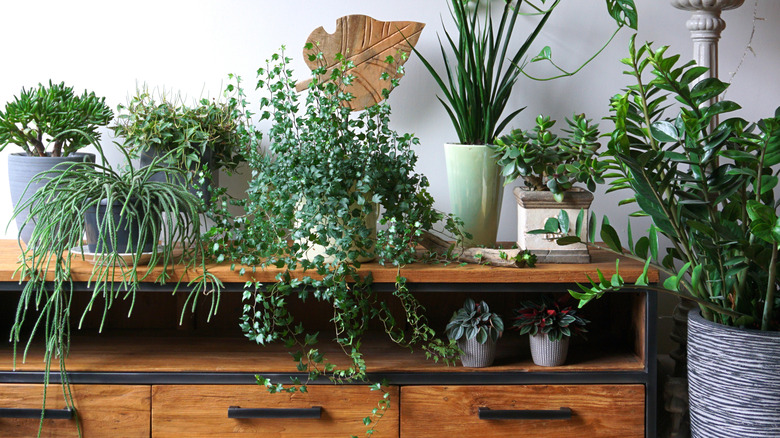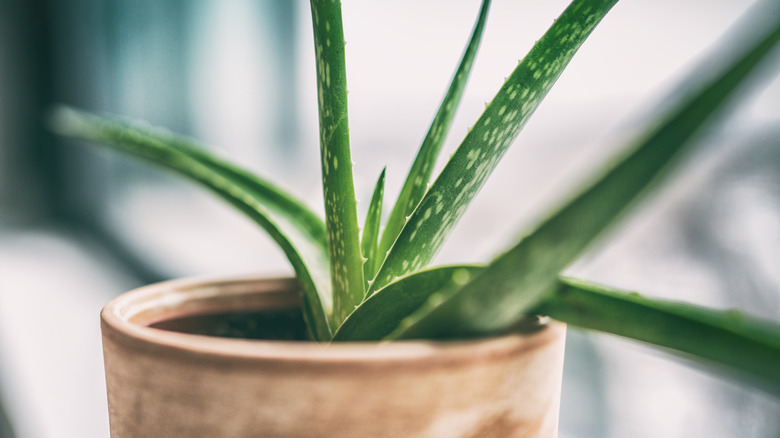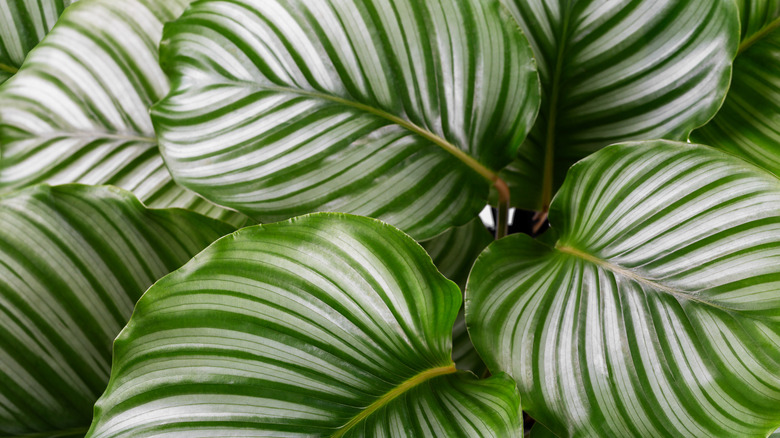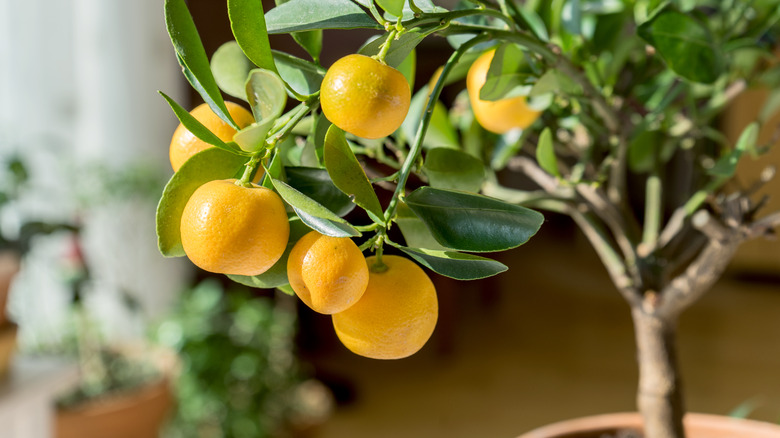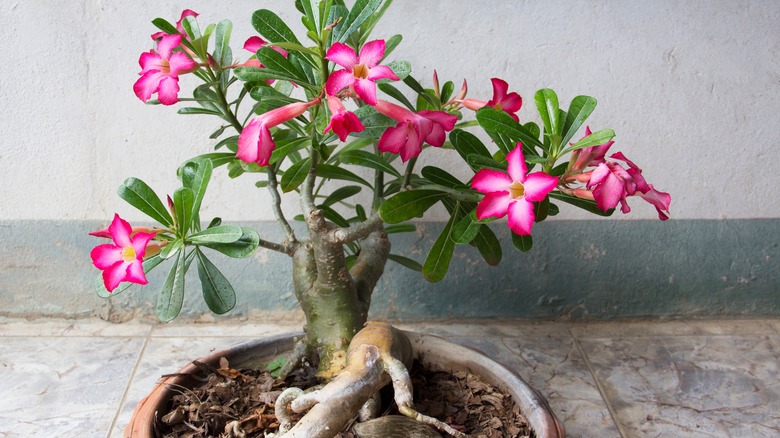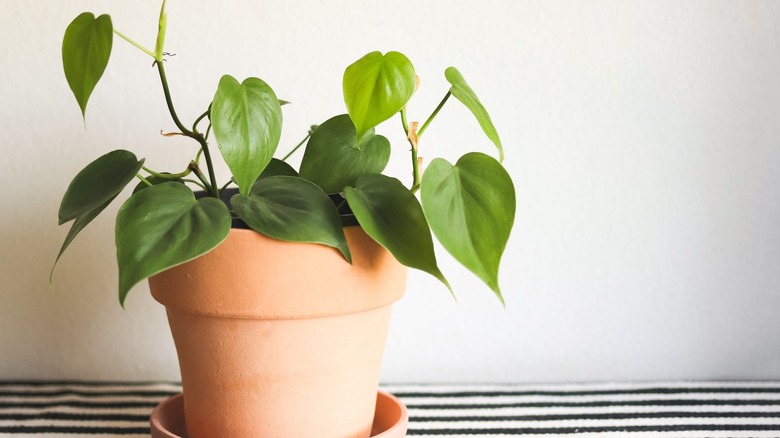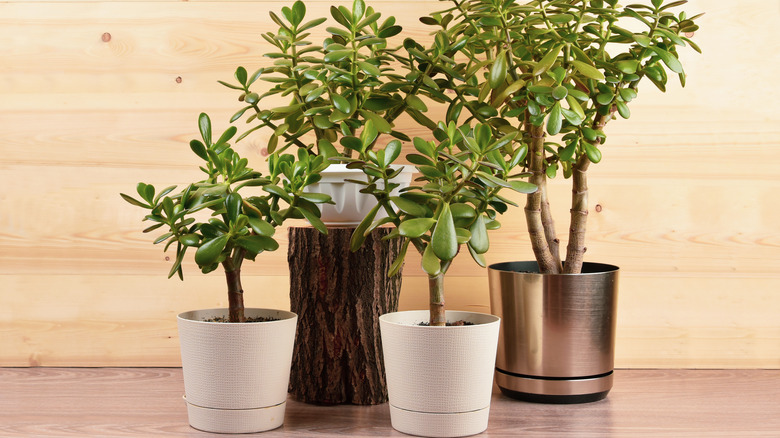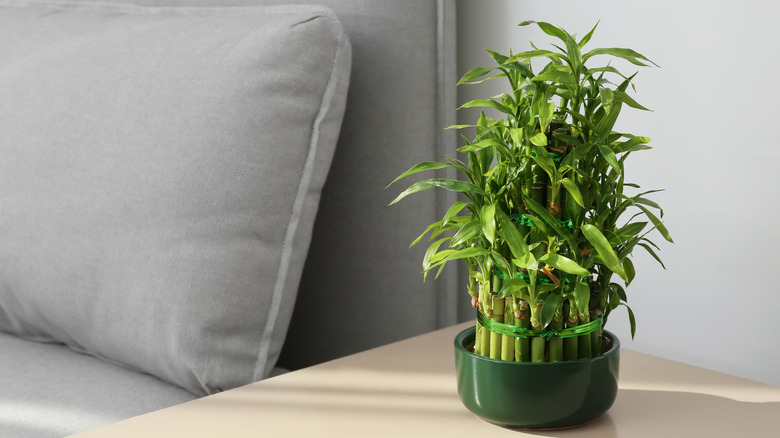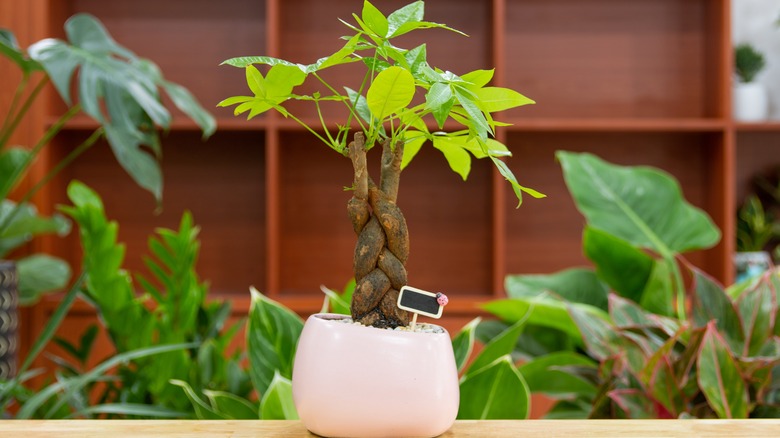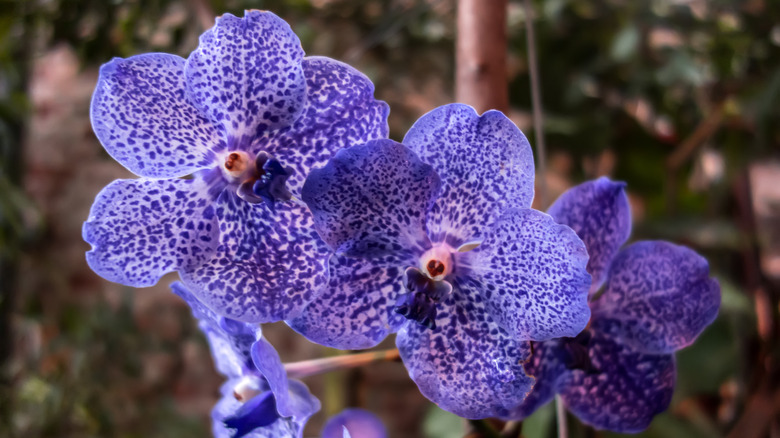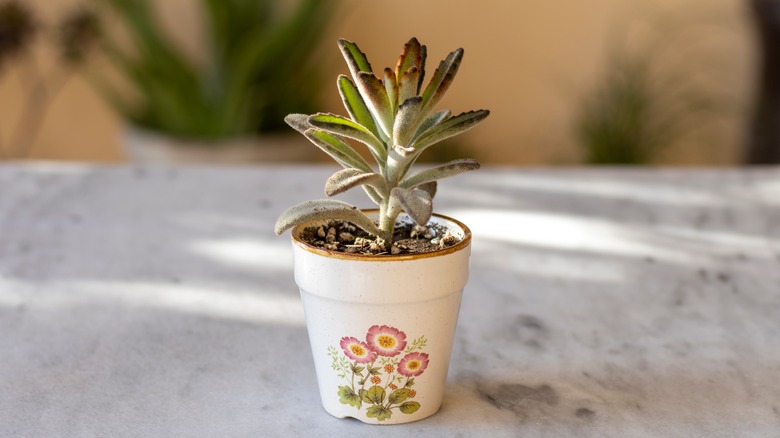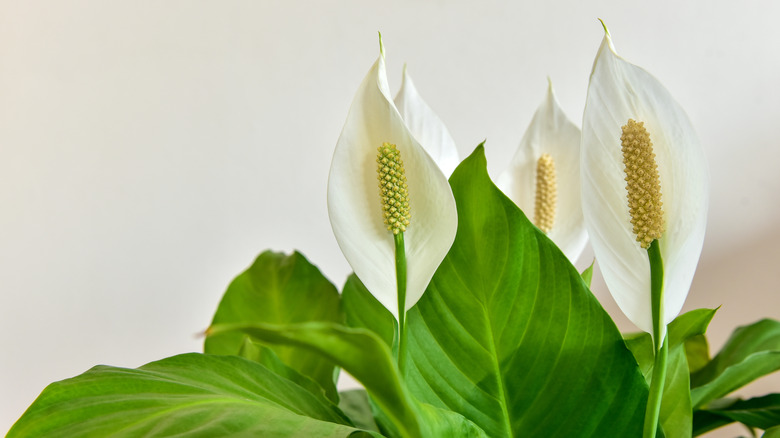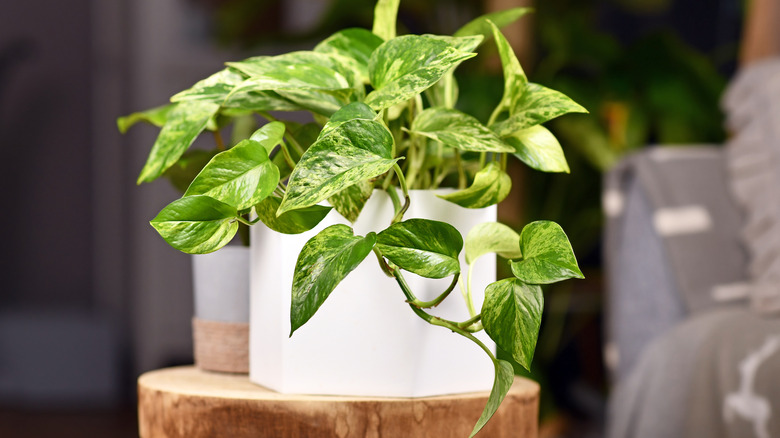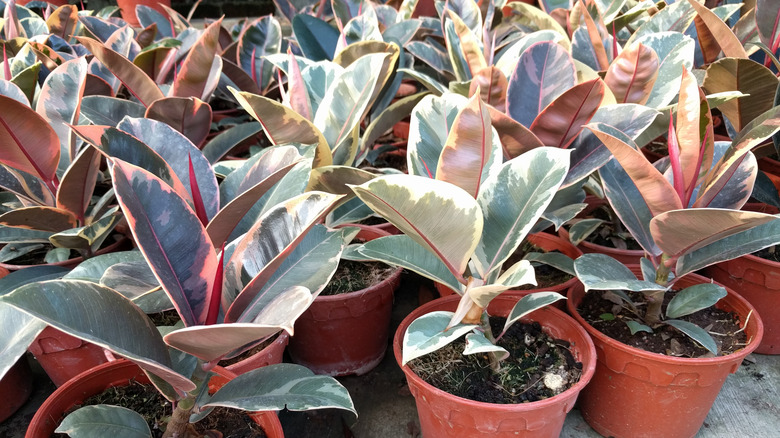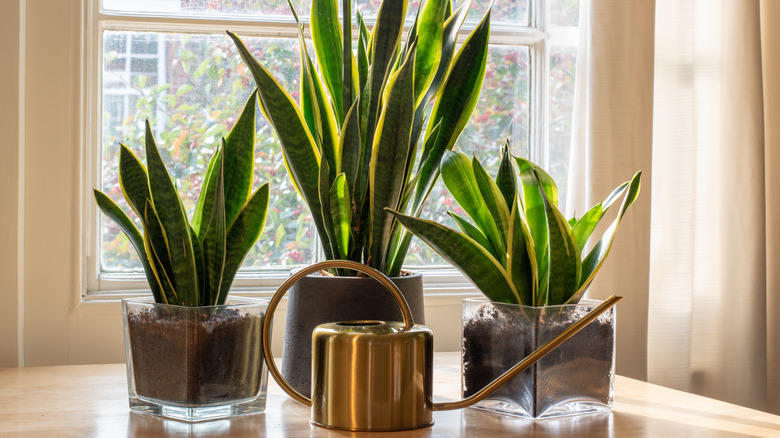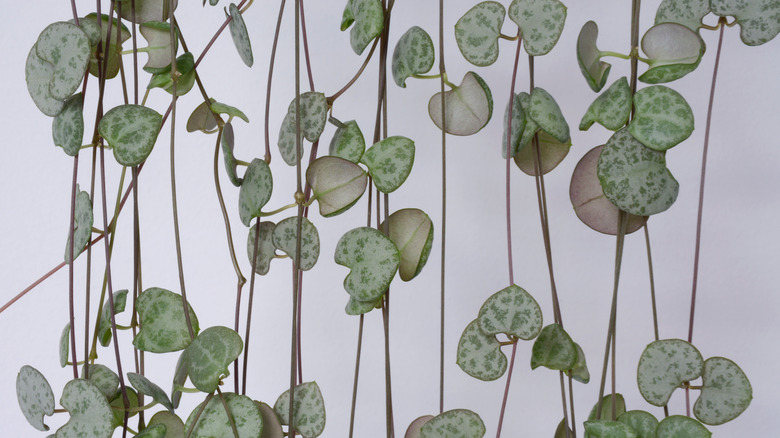15 Houseplants That Will Up Your Feng Shui Game
It's hard to go wrong when it comes to houseplants and feng shui, as the two go hand in hand when creating a peaceful and harmonious home. According to Lively Root, though, location matters when we find ourselves strategically positioning houseplants to attract the sometimes-fleeting positive energy of feng shui. For this reason, it's important to consult the bagua map and begin your greenery placement experiments in the eastern, southeastern, and southern areas of your home.
Furthermore, there are some types of plants that are considered to be just a little bit better at enticing auspicious chi than others. Any size houseplant will work in regard to feng shui, but if you're interested in trying to grow and care for a bonsai tree (which can be almost any variety of tree), you might consider some of the below options to get even more bang for your buck of hard work. Bonsai Tree Gardener explains that practicing the two art forms together will bring the grower that much more prosperity, love, and peace of mind.
1. Aloe vera
Aloe vera (Aloe barbadensis) is a bumpy-leafed succulent that stays pretty small. Per World of Succulents, vera comes from the Latin word for true, meaning this is the true aloe. In regard to feng shui, aloe vera belongs in the living room or kitchen, explains Succulents Grower. These plants are believed to bring luck and harmony while also absorbing negative chi energy.
Bloom Season: Spring and summer
USDA Growing Zone: 9 to 11
Growing Conditions: Bright indirect light
Soil Type: Very well-draining, succulent-specific potting mix
Size: Leaves up to 2 feet tall with 3-foot tall flower spikes
2. Calathea
The calathea (Calathea spp.) is a plant that symbolizes new beginnings, according to Coswell's Garden Center. It is an excellent choice for low-light conditions, and there are 60 species available in a wide range of foliage options from deep greens to dark maroons to emerald with white stripes like the Calathea orbifolia, shown above (via Epic Gardening).
Bloom Season: Unlikely to bloom indoors
USDA Growing Zone: 10 to 11
Growing Conditions: Bright yet indirect, also tolerates low light
Soil Type: Rich, loam, well-draining
Size: Up to 3 feet tall and 2 feet wide
3. Citrus
Lemons, kumquats, oranges, and tangerines all fall under the category of citrus trees (Citrus spp.), and a healthy potted citrus positioned in the wealth area of the bagua map may be all you need to experience prosperity and good fortune, suggests Petal Republic. Keep in mind that these trees prefer an indoor temperature range of at least 55 to 65 degrees Fahrenheit, per the University of Minnesota Extension.
Bloom Season: Spring
USDA Growing Zone: 8 to 11
Growing Conditions: Minimum 4 hours of direct sunlight daily
Soil Type: Moist, slightly acidic, well-draining
Size: Dwarf varieties grow 8 to 12 feet tall
4. Desert rose
Symbolizing abundance and fertility, according to the National Parks Board of Singapore, desert rose (Adenium obesum) is an auspicious plant for the home; its Chinese name even translates to wealth plant. The pink and red flowers are considered the luckiest. Per Missouri Botanical Garden, a container-grown desert rose will remain compact.
Bloom Season: Summer
USDA Growing Zone: 11 to 12
Growing Conditions: Full sun
Soil Type: Sandy or well-draining potting mix
Size: 3 to 9 feet tall and 3 to 5 feet wide
5. Heartleaf philodendron
Looking to bring some love into your space? You can't go wrong with the heartleaf philodendron (Philodendron hederaceum). Considering the fact that two Greek words make up this plant's name — phileo for love and dendron for tree (via Missouri Botanical Garden) — you'll probably want to try it in the love and relationships section of your home's bagua layout.
Bloom Season: Spring and summer
USDA Growing Zone: 10 to 11
Growing Conditions: Bright indirect light or part shade
Soil Type: Well-draining potting mix
Size: Up to 20 feet with support and 3 to 6 feet wide
6. Jade
Jade at the door, poor no more. This saying is well-known by practitioners (via Rolling Nature) and gives us neophytes a clear picture of just how important the money magnet jade plant (Crassula ovata) is within the art of feng shui. Keep it in a bright location, advises World of Succulents.
Bloom Season: Winter and spring
USDA Growing Zone: 9 to 11
Growing Conditions: Full sun
Soil Type: Very well-draining, succulent-specific potting mix
Size: Up to 8 feet tall
7. Lucky bamboo
Lucky bamboo (Dracaena sanderiana) seems like a pretty obvious addition to the list of auspicious feng shui boosters for the home. You'll often see lucky bamboo growing without soil in a glass container with just water. NC State Extension Gardener says to keep the plant away from direct sunlight and keep the water free from chlorine; pebbles in the container will offer the roots some structural support.
Bloom Season: Unlikely to bloom indoors
USDA Growing Zone: 10
Growing Conditions: Dappled sunlight to deep shade
Soil Type: Moist soil or water
Size: Up to 5 feet tall
8. Money tree
Just like lucky bamboo, the money tree (Pachira aquatica) is a well-known addition to any feng shui-inspired interior design. According to Epic Gardening, it's another one to keep away from harsh direct sunlight which will scorch its foliage. Oftentimes, money tree trunks are braided. To accomplish this yourself, you'll need a young plant with flexible stems that can be easily manipulated.
Bloom Season: Unlikely to bloom indoors
USDA Growing Zone: 9 to 11
Growing Conditions: Full sun to partial shade
Soil Type: Well-draining loam
Size: 6 to 8 feet tall and 1 to 2 feet wide
9. Orchids
Everyday Orchids says an orchid in the home improves happiness and will prove beneficial when placed in any bagua area where you'd like a boost. When picking one out, remember that purple is the luckiest color in feng shui, per Everyday Orchids, and look for something like the Vanda pachara 'Delight' variety pictured above. According to The Habitat, there's an orchid for every USDA growing zone.
Bloom Season: Spring
USDA Growing Zone: Varies by species
Growing Conditions: Bright indirect sunlight
Soil Type: Grow epiphytically or in orchid specific potting mix
Size: Varies by species
10. Panda plant
Panda plants (Kalanchoe tomentosa) are cute little buggers that like to grow in super sunny spots. They are good plants to introduce as you're striving to achieve balanced feng shui energy, notes Hortology. Gently rubbing the soft pastel foliage between two fingers is sure to lure you into a relaxed state of zen.
Bloom Season: Summer
USDA Growing Zone: 9 to 11
Growing Conditions: Bright indirect to partial shade
Soil Type: Very well-draining, succulent-specific potting mix
Size: Up to 2 feet tall
11. Peace lily
The African Garden notes that peace lilies (Spathiphyllum wallisii) do indeed symbolize peace, comparing their white blossoms to surrender flags. They've been grown indoors for centuries and are quite tolerant of low-light conditions. The wallisii variety shown above is small in size. It is not a true lily, however, the Old Farmer's Almanac notes that it is still mildly toxic when ingested.
Bloom Season: Spring and fall
USDA Growing Zone: 10 to 11
Growing Conditions: Part sun to shade
Soil Type: Well-draining, all-purpose potting mix
Size: Up to 12 inches tall
12. Pothos
The ever-popular and easy-to-grow pothos (Epipremnum aureum) is perfect for a hanging basket but also loves to climb up a moss pole, says the University of Madison-Wisconsin's Horticulture Extension. Like aloe vera, pothos is thought to not only increase positive energy but also absorb negative chi, reports Petal Republic, who suggest situating one in an empty corner where those negative vibes are most likely to accumulate.
Bloom Season: Does not flower
USDA Growing Zone: 10 to 12
Growing Conditions: Bright indirect sunlight
Soil Type: Well-draining and aerated
Size: Vines up to 65 feet long
13. Rubber tree plant
The ideal spot in your home for a rubber tree (Ficus elastica) is a sharply angled corner in the wealth sector, per Garden Tabs. For something a little different, look for a tricolor or 'Tineke' variety, which will have cream and pink on its foliage, as seen above. NC State Extension Gardener recommends warm indoor temperatures and medium levels of humidity.
Bloom Season: Unlikely to bloom indoors
USDA Growing Zone: 9 to 12
Growing Conditions: Full sun to dappled sun
Soil Type: Well-draining, tolerant of a range of types
Size: Up to 10 feet
14. Snake plant
Snake plants (Dracaena trifasciata) can maintain and improve the positive chi energy inside your home while also detoxifying the air, notes Healthline. Long considered a member of the Sansevieria botanical family, snake plants have been reclassified as dracaenas (via Leafy Place). Regardless of their name change, they remain fast-growing and easy-to-care-for houseplants.
Bloom Season: Spring
USDA Growing Zone: 10 to 12
Growing Conditions: Bright indirect sunlight
Soil Type: Loose, well-draining
Size: 28 to 35 inches tall
15. String of hearts
String of hearts plants (Ceropegia woodii) grow long vines, which can cascade over the sides of a hanging basket and form a screen of dangling hearts. Sounds kind of perfect for the love and relationships area of your home. Plants Rescue advises three to four hours of sun exposure per day followed by time in the shade.
Bloom Season: Summer and fall
USDA Growing Zone: 11
Growing Conditions: Light shade
Soil Type: Half coarse sand and half all-purpose potting mix
Size: Up to 3 feet long
